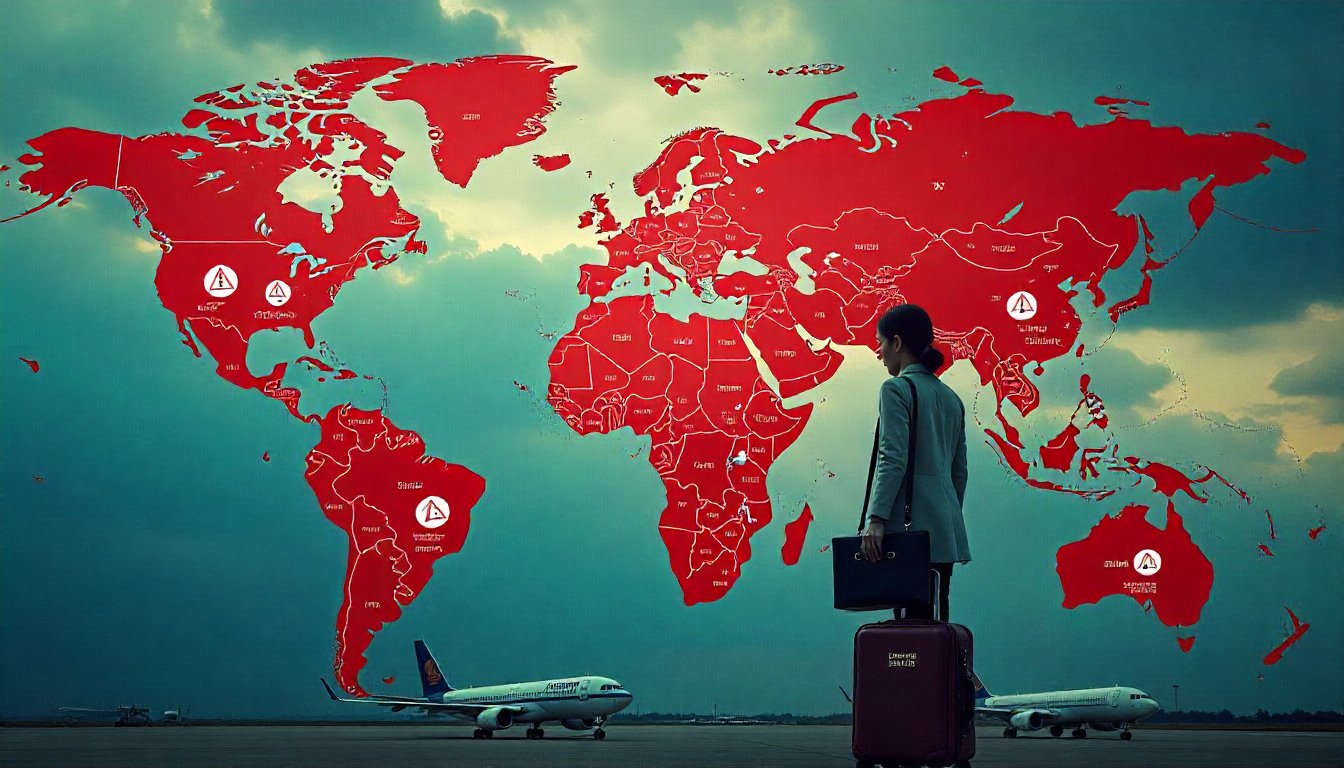Due to serious safety concerns, global travel authorities have issued a strict Do Not Travel Warning for 21 countries. These warnings are based on things like wars, terrorism, political unrest, threats of kidnapping, health emergencies, and bad infrastructure.
It’s very important to stay up to date on these travel warnings if you are going to another country. Knowing why some places are marked as unsafe can help you make better travel choices and stay safe.
There are 21 countries on the Do Not Travel list.
Because of security threats and unstable conditions, the following 21 countries are currently under the Do Not Travel Warning:
- Afghanistan
- Syria
- Yemen
- Somalia
- Libya
- South Sudan
- The Central African Republic
- North Korea
- Iraq
- Mali
- Venezuela
- Burkina Faso
- Belarus
- Haitian
- Iran
- Burma (Myanmar)
- Sudan
- Russia
- Congo, a Democratic Republic
- Lebanon
- Ukrainian
These countries are in different levels of danger, from violent wars to very high crime rates and not enough access to emergency services. Let’s look at what these warnings are based on.
Why these 21 countries are not safe
The Warning Not to Travel 21 Countries list includes nations where foreign visitors face high risks. The most important things are:
1. Wars and armed conflicts
Wars and civil unrest are having a big effect on countries like Ukraine, Syria, and Sudan. Travelers should avoid these areas because there are often fights, airstrikes, and bombings.
2. Threats to security and terrorism
Countries like Afghanistan, Somalia, and Iraq have a long history of terrorist attacks and attacks on specific people. In these unstable areas, foreigners are more likely to be in danger.
3. Protests and political instability
Myanmar, Venezuela, and Belarus are just a few of the countries that are having a lot of political trouble. These areas are dangerous and hard to predict because of big protests and government crackdowns.
4. Organized crime and kidnapping
Haiti, Libya, and Burkina Faso all say that kidnapping for ransom is on the rise. Criminal groups often go after foreigners, which puts travelers in a lot of danger.
5. Health Risks and Bad Infrastructure
There are humanitarian crises, disease outbreaks, and not enough healthcare facilities in Yemen, South Sudan, and the Central African Republic. There aren’t many emergency services, so these places aren’t safe if you get sick or hurt.
The 21 Countries by Region Middle East
Afghanistan, Syria, Yemen, Iraq, Iran, and Lebanon
Terrorism, armed conflict, and political instability are problems in these countries.
- Africa
Somalia, Libya, South Sudan, the Central African Republic, Burkina Faso, the Democratic Republic of the Congo, and Sudan
Travel is dangerous because of frequent wars, militia violence, and bad roads.
- Europe and the area around it (Belarus, Russia, and Ukraine)
These places are very dangerous because there are still wars going on and political tensions are high.
- Asia(North Korea and Myanmar)
Risks include strict government rules, unpredictable security situations, and not enough help.
- The Americas(Haiti and Venezuela)
Both countries are on the verge of economic collapse, have a lot of organized crime, and are seeing a lot of protests.
Before you go to any country, here are some travel safety tips:
It’s important to stay alert when you travel to any country, even if you’re not going to one of these 21 restricted ones.
Here are some ways to stay safe:
1. Look at the official travel warnings
Before you book your trip, always check the travel warnings issued by the government to stay away from high-risk places.
2. Have emergency contacts ready
Keep the phone numbers and addresses of your country’s embassy or consulate on hand in case of an emergency.
3. Stay away from public protests and gatherings
It is safer to stay away from large crowds in areas where politics are unstable because they can quickly become violent.
4. Get full travel insurance
Pick a plan that covers medical emergencies, cancellations, and evacuations in an emergency.
5. Keep up with what’s going on in your area
During your trip, keep an eye on real-time updates from trustworthy news sources and local officials.
How to Make Your International Trips Safer
If you take the right steps, traveling to other countries can be safe. Here are some tips for lowering risks when you plan your next trip:
- Before you make your travel plans, do a lot of research on your destination.
- Make reservations at hotels that are safe and secure.
- Use Reliable Transportation instead of services that aren’t verified.
- Avoid showing off your wealth to lower the risk of theft or robbery.
- While you’re away, stay in touch with family and friends.
Why You Should Pay Attention to the Do Not Travel Warning
Ignoring the Do Not Travel Warning for 21 Countries can have serious effects, such as:
- Higher chance of being kidnapped or attacked violently
- Being around terrorism and armed conflicts
- Not enough access to medical help
- Problems with sudden lockdowns or evacuations
- Arrest or detention because of unstable legal systems
You can keep yourself safe and have safer trips by following these travel tips and staying away from places that are known to be dangerous.
In conclusion
The Do Not Travel Warning 21 Countries list shows places where safety is a big concern because of wars, terrorism, political unrest, or health risks. Before you go anywhere outside of your home country, always check official travel warnings, learn about your destination, and take steps to make sure you have a safe and secure trip.
It’s fun to travel, but safety should always come first. You can make better travel choices and feel safe no matter where you go if you stay informed.


